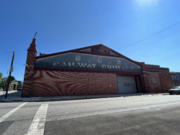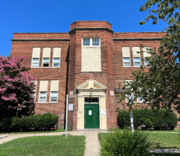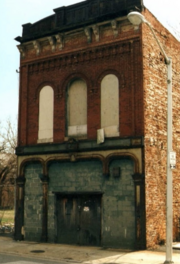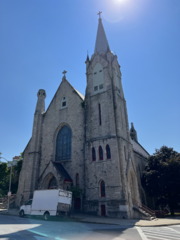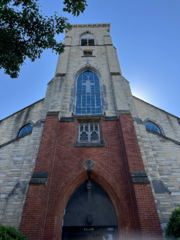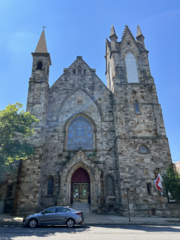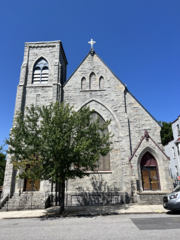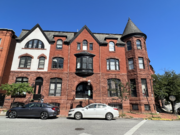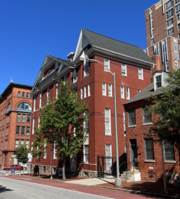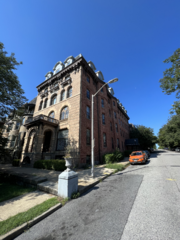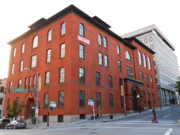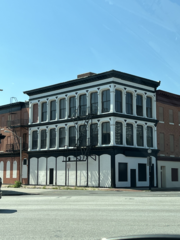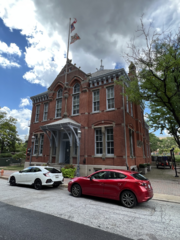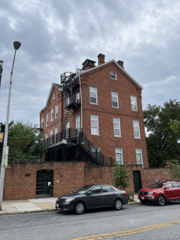Difference between revisions of "Frank E. Davis"
| Line 1: | Line 1: | ||
{{Arch | {{Arch | ||
| − | |birth_date=1839 | + | |birth_date=August 14, 1839 |
|birth_approx=No | |birth_approx=No | ||
| − | |death_date=1921 | + | |death_date=April 19, 1921 |
|death_approx=No | |death_approx=No | ||
| − | |death_place=Los Angeles, | + | |death_place=Los Angeles, California |
| − | }} | + | |birth_place=Ellicott Mills, Maryland}} |
{{Biography}} | {{Biography}} | ||
| − | {{NewArchitectPageFormat}} | + | Francis Earlougher Davis was born in Ellicott Mills, Maryland on August 14, 1839. He was raised in this Patapsco River Valley town where his father was a blacksmith and wainwright. During the Civil War, Davis worked as a draftsman in the Treasury Department in Washington; after the war, he spent two years as a surveyor in the oil fields in Pennsylvania. |
| + | |||
| + | Davis’s career as an architect began as a draftsman or an apprentice, working for three years under Edmund G. Lind (1829-1909) in Baltimore. He also was a student at the new Maryland Institute of Art and Design, earning top honors and an award of $100. Frank Davis was elected to membership in the Baltimore Chapter of the AIA in December 1870. | ||
| + | |||
| + | In the late 1860s, Frank Davis formed a partnership with Thomas Dixon (1819-1886) that lasted only a few years. During most of the 1870s, Davis practiced alone. He formed a partnership with a younger brother Henry late in that decade or in the early 1880s. In their partnership, Frank was the architect and Henry was the builder. In some projects, they were joined by an older brother, William, who had an ornamental ironworks business. The office of Davis & Davis was located on the southeast corner of Charles and Fayette Streets in Baltimore. | ||
| + | |||
| + | The known works of Frank Davis have been identified from articles in the ''Baltimore Sun'' and the ''American Architect and Building News'', various other published sources, and a list hand-written by Davis himself. Residential and business work ranked highest in Davis’s oeuvre, followed by religious and cultural buildings, educational and railway projects, and finally government and health care. Davis’s own list, probably written in about 1895, claimed five Baltimore city firehouses, five courthouses, nearly two dozen schools, and over fifty churches. Davis also designed his own home at 802 North Carrollton Avenue. | ||
| + | |||
| + | Most of Davis’ well-known work is in Maryland, but he was responsible for many works in West Virginia and Pennsylvania. A few have also been found in Virginia and Delaware. The tally of known Davis works, by state, is as follows: Maryland: 178 (100 in Baltimore City alone, 23 in Baltimore County); Pennsylvania: 13 (8 in Harrisburg); West Virginia: 10; Virginia: 5; Delaware: 5; Washington DC: 1. About 200 works have been firmly attributed to Davis; another 20 have been identified as probables. About half of Davis’ buildings are extant. Frank Davis’s work is represented by at least ten buildings currently listed on the National Register of Historic Places. | ||
| + | |||
| + | Frank Davis practiced in Baltimore until about 1914, when he retired and moved to southern California to live with two of his sons, Francis Pierpont Davis and Walter Swindell Davis. Frank Davis died in Los Angeles on April 19, 1921. He was survived by his wife and five of his six children.{{NewArchitectPageFormat}} | ||
==Biography== | ==Biography== | ||
[[Category:Architects|Davis, Frank E.]] | [[Category:Architects|Davis, Frank E.]] | ||
Revision as of 11:49, June 1, 2022
| Frank E. Davis | |
|---|---|
| General Information | |
| Birth | August 14, 1839 Ellicott Mills, Maryland |
| Death | April 19, 1921 Los Angeles, California |
Biography
Francis Earlougher Davis was born in Ellicott Mills, Maryland on August 14, 1839. He was raised in this Patapsco River Valley town where his father was a blacksmith and wainwright. During the Civil War, Davis worked as a draftsman in the Treasury Department in Washington; after the war, he spent two years as a surveyor in the oil fields in Pennsylvania.
Davis’s career as an architect began as a draftsman or an apprentice, working for three years under Edmund G. Lind (1829-1909) in Baltimore. He also was a student at the new Maryland Institute of Art and Design, earning top honors and an award of $100. Frank Davis was elected to membership in the Baltimore Chapter of the AIA in December 1870.
In the late 1860s, Frank Davis formed a partnership with Thomas Dixon (1819-1886) that lasted only a few years. During most of the 1870s, Davis practiced alone. He formed a partnership with a younger brother Henry late in that decade or in the early 1880s. In their partnership, Frank was the architect and Henry was the builder. In some projects, they were joined by an older brother, William, who had an ornamental ironworks business. The office of Davis & Davis was located on the southeast corner of Charles and Fayette Streets in Baltimore.
The known works of Frank Davis have been identified from articles in the Baltimore Sun and the American Architect and Building News, various other published sources, and a list hand-written by Davis himself. Residential and business work ranked highest in Davis’s oeuvre, followed by religious and cultural buildings, educational and railway projects, and finally government and health care. Davis’s own list, probably written in about 1895, claimed five Baltimore city firehouses, five courthouses, nearly two dozen schools, and over fifty churches. Davis also designed his own home at 802 North Carrollton Avenue.
Most of Davis’ well-known work is in Maryland, but he was responsible for many works in West Virginia and Pennsylvania. A few have also been found in Virginia and Delaware. The tally of known Davis works, by state, is as follows: Maryland: 178 (100 in Baltimore City alone, 23 in Baltimore County); Pennsylvania: 13 (8 in Harrisburg); West Virginia: 10; Virginia: 5; Delaware: 5; Washington DC: 1. About 200 works have been firmly attributed to Davis; another 20 have been identified as probables. About half of Davis’ buildings are extant. Frank Davis’s work is represented by at least ten buildings currently listed on the National Register of Historic Places.
Frank Davis practiced in Baltimore until about 1914, when he retired and moved to southern California to live with two of his sons, Francis Pierpont Davis and Walter Swindell Davis. Frank Davis died in Los Angeles on April 19, 1921. He was survived by his wife and five of his six children.
Projects
Map
| Library |
Church |
Government |
Commercial |
Dwelling |
Park |
Educational |
|---|
Listing
| Project | Completed | Address | Image |
|---|---|---|---|
| Project | Completed | Address | Image |
| Baltimore County School No. 7 | 1882 | 200 Ashland Rd. | |
| BCP Railway Car Barn and Offices | 1879 | 2560 Madison Ave | |
| Clifton School | 1882 | 2670 Kennedy Ave | |
| Engine House No. 8 | 1871 | 1031 W Mulberry St | |
| First English Lutheran Church | 1875 | 823 W Lanvale St | |
| First English Reformed Church (Aisquith Street) | 1867 | 417 Aisquith St | |
| Grace Methodist Episcopal Church | 1876 | 1121 W Lanvale St | |
| Holy Innocents Protestant Episcopal Church | 1880 | 1100 N Eden St | |
| James Thompson Townhouses | 1885 | 206 Laurens Street | |
| Male Grammar & Primary School No. 1 | 1880 | 520 W Fayette St | |
| Maryland Bicycle Club | 1885 | 2028 Mt Royal Terrace | |
| Odd Fellows Hall | 1891 | 300 Cathedral St | |
| Old Town Savings Bank | 1871 | 353 N Gay St | |
| Pine Street Police Station | 1877 | 214 N Pine St | |
| Saint Michael’s Church Convent | 1874 | 1901 E Lombard St |
